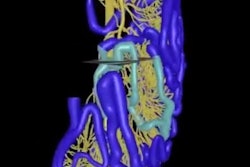Dear CT Insider,
The recent meeting of the International Society for Computed Tomography (ISCT) was a tour de force that illustrated the versatility of CT -- a modality whose reputation is continually being renewed by innovations that make for better healthcare. This issue of the CT Insider looks at the modality from multiple angles that highlight CT's rapid evolution in imaging.
In CT instrumentation, the development of ultrahigh-resolution CT imaging promises exquisitely detailed images highlighting pathology that previously went unseen. Technologies such as photon-counting CT are in development at major manufacturers, producing amazing new levels of detail. Learn more about what's going on by clicking here.
Speaking of ultrarealistic images, a new CT technique called cinematic rendering is upping the ante for 3D rendering. Cinematic rendering results in images that are almost indistinguishable from real anatomy, said Dr. Elliot Fishman of Johns Hopkins University in a talk at ISCT 2017. The ultrarealistic images are tailor-made for oncology imaging, visualizing complex vascular structures such as aortic dissections and aneurysms, and for musculoskeletal and orthopedic work. Find out more by clicking here.
In computer-aided detection, radiologists from the U.S. National Institutes of Health (NIH) have set their sights on a fully automated abdominal analysis tool that can take a CT volume and automatically find everything from kidney lesions to osteoporosis to small-bowel masses at the push of a button. No, it's not ready for clinical use yet, and investigators aren't sure when it will be. But they have many of the individual components nailed down, and from where we sit, "Star Trek CT," the final chapter, seems inevitable. Learn more about how the NIH is doing it here.
Then there's artificial intelligence (AI), the brains behind much of the advanced image analysis that finds telltale patterns in CT data. In his presentation at ISCT 2017, Dr. Eliot Siegel of the University of Maryland offered solid advice on how AI developers can make their algorithms more useful. One suggestion is to have AI focus more on nonimaging applications rather than just duplicating work that radiologists do. And Dr. Siegel has six other good ideas in this issue's Insider Exclusive, brought to you as a subscriber before our other members can access it.
Still, for a CT practice to be viable, it has to offer value to those who are giving up their own resources to get it. According to ISCT course director Dr. Geoffrey Rubin from Duke University Medical Center, that value depends in no small measure on who's looking at it or for it. For their part, patients just want their CT experience to be competent and comfortable. Find out more here.
Who's responsible for the CT value chain anyway, the department or the hospital? Discover the advantages of one approach over the other by clicking here.
We invite you to scroll through the links below for the rest of the news from radiology's master modality, all here in your CT Community.



















